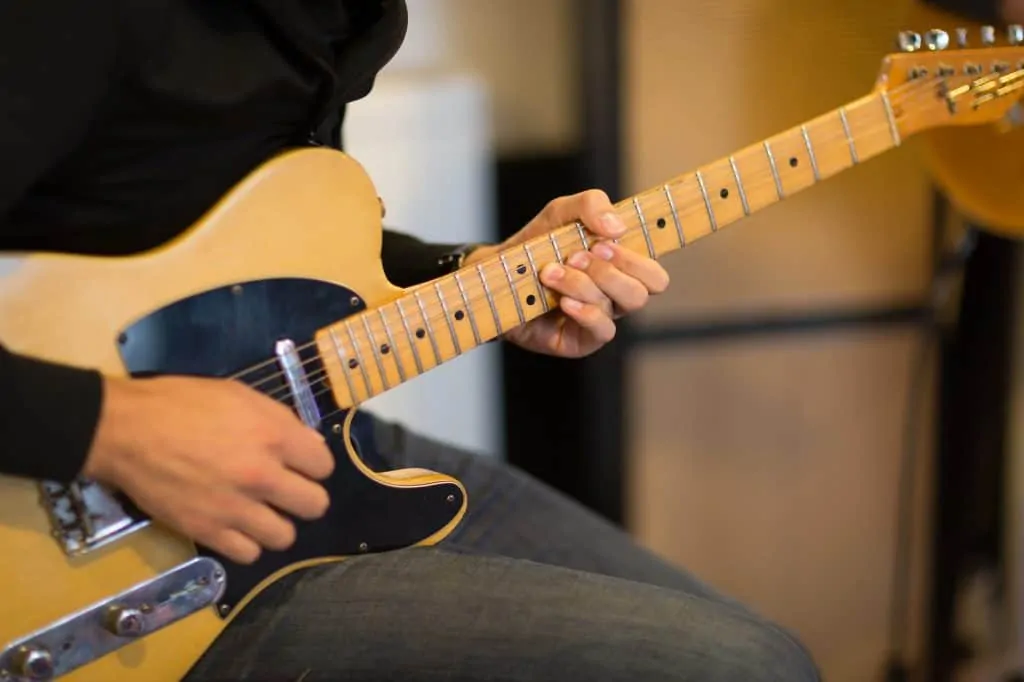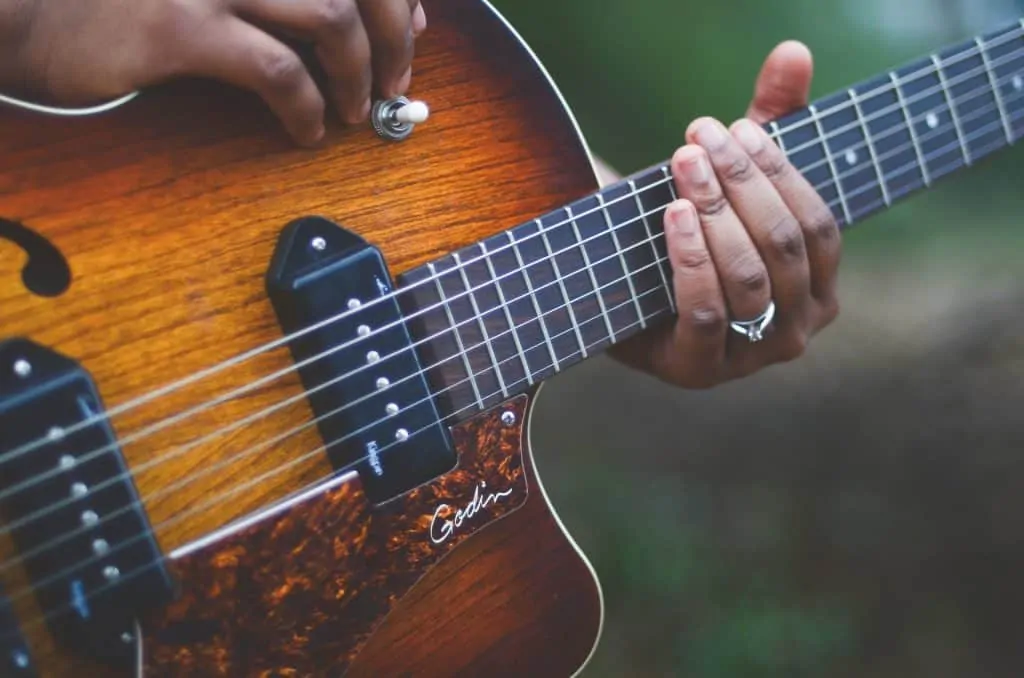In the annals of jazz guitar, few players are as revered as Wes Montgomery. The Indianapolis native’s work fused swing and blues with the emerging bebop and hard bop styles of his heyday, creating a timeless style that influences countless players to this day.
Montgomery, as many jazz players will tell you, created vast swaths of the language of modern jazz guitar. If you’re interested in playing jazz, his solos and compositions offer a wealth of knowledge for you to use. And while Montgomery possessed fast fingers and an encyclopedic knowledge of extended chords, many of his techniques are accessible enough for beginner and intermediate players to understand.
It’s nearly impossible to summarize all of the different facets of Montgomery’s style in just one article — but we’re going to try! This guide will break down Montgomery’s stylistic influences, then examine a couple of the techniques he uses to achieve the effects he does. Finally, we’ll give you a few licks from his solos to help you work Montgomery’s style into your own playing.
Contents
Background
To play guitar like Wes Montgomery, it’s essential to understand his style. His concrete techniques are important — and we’ll discuss them in a bit — but understanding Montgomery’s style goes further than just copying a couple of licks. By learning about Montgomery’s influences and habits, you can structure your solos like he does and better assimilate his feel and patterns into your own playing.
Influences
Though modern guitarists remember Wes Montgomery as one of the most unique players in the history of jazz, within his style it’s still possible to hear the influence of his early idols.
With his speed and precision, Charlie Christian paved the way for generations of other jazz guitarists.
Charlie Christian
Out of all other guitar players, Charlie Christian undoubtedly had the biggest effect on the young Wes’ development. While Montgomery only began playing guitar seriously at the age of 19, it took him just eight months to commit all of Christian’s solos on Benny Goodman’s record Solo Flight to memory.
Listen to any of Christian’s solos, and you’ll immediately recognize many of what would later become Montgomery’s calling cards. Indeed, Montgomery developed most of his impeccable rhythm and swing feel from players like Christian and other swing-era big bands.
The heavy syncopation and offbeat lines that Wes would later popularize in the hard bop era also came courtesy of Christian. Wes took Christian’s lilting, bouncy approach to jazz guitar and built off of it for bop rather than swing.
Charlie Christian may also be the source for Wes’ affinity for big-band arrangements on some of his records. While many of Montgomery’s live shows (particularly Smokin’ At The Half Note, widely regarded as his magnum opus) only feature a quartet or quintet, his studio albums (like Bumpin’) often include backing from horns and strings that sound like a full orchestra at points.
As we’ll discuss later, Christian’s influence also pushed Montgomery to develop simple, melodic hooks throughout his solos and to remain grounded in more fundamental concepts while some of his contemporaries soared to abstract and tangential solos.
Blues
Beyond Christian, Wes was also influenced by the blues. Even as other players in his generation expanded into more abstract solos stuffed with complex extended chords and endless scales, Montgomery hung on tight to a core blues feel and simplistic lines.
Though he received much of his blues knowledge through the impact of Charlie Chrstian, Montgomery nevertheless incorporated a few aspects of the blues into his own style. One of the best examples is call-and-response, as Wes uses (to great aplomb) in the solo from Four on Six.
Take a look at the diagram above, and notice how the first part of each measure mirrors the second part of the line. This sort of repetition is common in 12-bar blues, particularly during vocals on verses. The call-and-response format, meanwhile, stems from gospel music and is a common tactic for blues guitarists during blues turnarounds and while they solo.
Other influences of the blues on Wes’ (and Christian’s) playing style are a bit more abstract. Though Montgomery could burn up the fretboard when he wanted to, he often eschewed abstract scale runs for hard-edged rhythmic lines. More often than not, these lines incorporated rhythmic elements of the blues like triplets, excessive repetition of short phrases, and hard syncopation.
Wes’ blues influence rubbed off on more than just his line structures, though. He was particularly fond of blues-based chromatic melodies, often hitting blue notes during his solo. And for all of his hard bop influences, many of his licks straddle the edge between blues and jazz — particularly in smoky, relaxed vamp compositions like his famous “Bumpin’ on Sunset.”
Analyzing how Wes Montgomery structures his playing can help you transport his style to your own guitar skills.
Playing Style
While we’ve already hinted at some parts of Wes Montgomery’s guitar style, there are other important factors you’ll need to learn before you can apply Wes’ lines to your own playing. In this section, we’ll talk about the specifics of Montgomery’s playing style to help you get a better grip on the Thumb’s famous playing traits.
Solo Structure
Each one of Wes’ solos was different, though many of them followed a very similar structure. Learning how Montgomery built his solos from the ground up is an essential part of learning how to play guitar like he did. And while playing a solo organized like a Wes solo today may seem a bit copycattish, you can still apply these lessons to your own improvisation in a much more subtle manner.
Single Notes
Montgomery nearly always began his solos with single notes arranged in runs up and down the fretboard. This was (and still is) a common tactic for jazz soloists; it shows off both their knowledge of the instrument and their improvisational prowess. Montgomery would sometimes span multiple octaves with his opening lines in a solo before bringing things back down to earth.
A great example of this technique is Montgomery’s 1965 live recording of his composition “Full House.” The solo section begins with 16 bars that vamp between Fm7, Bb7, and C7 — the i, IV, and V chords found in a traditional 12-bar blues format. These simple yet dissonant chords allow Wes to take off and find notes anywhere on the neck that fit the sound of the piece. Take a listen to this recording below:
Octaves
After a little while soloing with single notes, Montgomery would shift gears and play notes in octaves. This technique quickly became one of Wes’ calling cards and set him apart from other jazz guitarists of his era. Even today, many guitarists regard playing lines in multiple octaves as a “Montgomery-sounding” strategy.
Playing notes in octaves creates a warmer, fuller sound with a natural chorus effect between the two different notes. Because it’s difficult to fret both notes at the same time (almost always with a muted string in between), Montgomery’s lines became much simpler after he switched to octave playing in his solos versus when he played only single notes.
To keep the solos interesting without the use of blazing runs, Wes emphasized rhythm and swing feel above virtuosity when he played with octaves. Out of all of his techniques, this is maybe one of the most versatile for guitar players today to learn. You can apply his sense of time and groove to practically any genre around — it will sound particularly good in jazz, rock, and blues as well.
Even if you can’t manage to fret both octaves, try to transcribe some of Wes’ octave lines and pick up the pulsing rhythmic feel. You’ll likely notice how big of a role repetition and syncopation played in creating Montgomery’s incredible playing style. Later, you can revisit the solos and incorporate both octaves into your transcription for a warm and silky sound.
Chordal soloing can take years to master, but the final results are stunning.
Chordal Soloing
Finally, Wes would cap off many of his solos by soloing with entire chords at a time. Yes, you read that right. In technical terms, his chordal soloing techniques built closely upon his octave soloing techniques — Montgomery didn’t play as many notes per measure, and prioritized repetition and melodicism with the notes that he did play in order to keep his listeners engaged.
For most guitarists, however, chordal soloing is far out of reach. Wes honed his guitar skills by practicing jazz standards and techniques every night. Even for a virtuosic talent, it still took him years to refine his signature techniques until he broke through onto a global stage.
If you don’t have the free time or inclination to spend this long practicing straight-ahead jazz guitar, you’ll probably never reach Wes’ chordal soloing level. However, that’s not to imply that all other guitarists are somehow inferior to Montgomery because they don’t play chordal solos! On the other hand, chordal solos have become so recognizable as one of Montgomery’s tactics that breaking out a chordal solo on a tune at your local jam session may sound forced and out of step rather than seamless and virtuosic. To establish your own voice when playing lead guitar, you won’t be able to slide by on chordal soloing alone.
To reap the benefits of studying chordal solos without needing to transcribe every single measure, you can opt instead to transcribe just the melody tones. These are the notes that form the base of each chord; oftentimes they’re the root not but they can also be the top note of the chord. If you struggle to pick out the melody notes, try distilling the chords down in your head — the melody notes should be the ones you hear in your head when you think of a certain chordal run. You can also try whistling the pattern; the melody notes would be the notes that you’d whistle (if you were to whistle a late-stage Wes Montgomery solo).
By removing all of the extraneous notes and extensions from the makeup of the chords, you can analyze how Montgomery manipulates the central emotions of the sound throughout very detailed chord changes during his solo. If you enjoy listening to his style, you can even take some of Montgomery’s chordal soloing licks and deploy them as single-note riffs on your own!
Motifs and Repetition
Jazz solos often stretch on for so many choruses that it can be difficult for listeners to keep track of all of the changes. Beginners and advanced players alike are guilty of playing scale runs that lead back into nothing, alienating the audience and removing any sense of melodic direction.
Montgomery’s solos are remarkably different from this “endless scales” approach. As we’ll explain in more depth later, Wes used repetitive, groovy motifs along with his complex scale licks. While they may be more simple than rapid-fire runs, these motifs kept listeners engaged and helped Montgomery achieve a greater swing feel than his contemporaries.
If you’re ever stuck during a solo, establishing motifs can be a great way to inject some extra structure and flair.
Techniques
Wes Montgomery’s techniques may be even more famous than the details of his playing style. Some of these techniques are easy to apply, while others are unique to Montgomery himself and don’t translate very well to other players. If you want to play the guitar exactly like Wes, however, you should try to adopt these mechanics.
Playing with the thumb is Wes Montgomery’s signature technique — it’s essential if you want to capture the master’s style.
Playing With The Thumb
This is undoubtedly the most distinctive feature of Wes Montgomery’s playing. It’s so famous, in fact, that Montgomery even composed a song called “The Thumb” to honor his technique!
Wes initially developed the technique to lower the volume on his late-night practice sessions. Using a pick woke up his family and neighbors, much to their chagrin — by playing only with his thumb, he kept quiet but continued to practice for hours at a time.
But while it may have sprung out of necessity, Montgomery’s style of picking with his thumb also had a distinctive sonic effect. Compared to playing with a pick, his thumb created a warmer, smoother sound that suited jazz guitar perfectly. When combined with his favorite Gibson hollow-body guitars, Montgomery was able to seamlessly merge natural acoustic tones with amplified electric volume.
Classical Fingerstyle vs. Thumb-picking
Fingerstyle playing captures a lot of the woody, full-bodied sounds that Montgomery captured with his thumb. If you’re more comfortable playing with all of your fingers, you may be able to mimic Wes’ tones by playing traditional fingerstyle guitar. However, even compared to fingerpicking, the Montgomery thumb technique sounds distinct.
Montgomery often leveraged the power of his thumb to dig through strings much harder than classical fingerstyle players do. Listen to any of his recordings (particularly live solos) and you’ll hear the percussive, round, “popping” sound this force created. It’s hard to replicate with fingerstyle playing for a couple of reasons. Chief among them is the direction — fingerstyle players pick the strings upwards from the far side of the body, whereas Montgomery played the vast majority of his lines pressing down on the strings.
Playing only with his thumb also forced Wes to switch from string to string in a staccato manner similar to playing with a pick. Fingerstyle players, on the other hand, can pluck notes on different strings with different fingers to create a legato, flowing sound. If you play Wes Montgomery’s pieces with classical fingerstyle technique, you’ll need to mute the strings after you play each note. For octave notes, you may also need to swipe down with your thumb in order to hit both strings at the same time with a rhythmic staccato feel.
Downstrokes and Upstrokes
Wes’ technique also varied slightly between single notes and chords. He always played chords with a downstroke using the fleshy part of his thumb. The softer surface created a subdued, slightly muffled response that worked great for rhythm playing and background comping. Depending on the specific situation, he could use the side of his thumb as well.
For solo notes, Montgomery alternated between downstrokes and upstrokes. He played downstrokes in a manner very similar to chords — with the fleshy part of his thumb, or with the side if he was moving down across multiple strings at a time. For upstrokes, however, he struck the strings with the broad side of his thumbnail.
This sound is a lot closer to the sound of a traditional pick. It creates a rhythmic and percussive contrast with the smoother, softer downstrokes, particularly when Montgomery played long runs. When he wasn’t flying up and down the fretboard, he often used the contrast between the two picking styles to create syncopated and groovy repeated lines. The added texture helped even melodically simple concepts stand out from the playing of other guitarists.
Emulating the Technique
By planting the rest of his fingers on the body of his guitar around the pickguard, Wes freed up his thumb to pick back and forth without grounding it on the strings or by the bridge. If you want to emulate Wes’ thumb-picking style, you’ll have to keep your thumb elevated off of the strings. It can be difficult to copy the specifics of Wes’ thumb style since it’s so unique; watching live videos of him playing is a great way to get a closer look at the specifics of his moves.
This is a tough transition for a lot of guitarists who are used to playing from behind the bridge. While you’ll get far closer to Montgomery’s unique tone if you use your thumb, you may not be able to play all of his songs if you’re not comfortable with the technique. Take your time and practice slowly to get up to speed when playing with your thumb.
An Epiphone Casino, one of the thinline models we highlight.
Hollow-Body Guitars
While this technically isn’t a mechanical technique like “playing with your thumb” is, it’s so important to Montgomery’s style that it merits inclusion here nonetheless! Throughout his career, Montgomery played hollow-body jazz boxes nearly exclusively. These guitars, particularly the Gibsons that he favored above all, have a uniquely warm tone that’s incredibly hard to replicate with a solid or semi-hollow axe.
If you want to copy Montgomery’s tone down to the exact specifics, you should consider a Gibson L-5. While its incredibly high price tag sets the L-5 out of reach for most players, it’s the model that Wes used for the vast majority of his career (including practically all of his most famous recordings). Beyond Montgomery, an L-5 is an incredible guitar for playing all different types of jazz. Simply put, it’s one of the most iconic jazz boxes ever made.
Of course, the L-5 is so expensive that it’s an unreasonable purchase for everyone but the most dedicated jazz fans. Beyond that axe, you can find a ton of other hollow-body guitars that can give you a great approximation of the woody, thick L-5 sound.
Some of these models are full-sized jazz boxes, which resemble an acoustic guitar in size and weight. Others are thinline axes, which are significantly smaller and play more like a solid-body electric. These instruments are more versatile for genres outside of jazz, like rock and roll, blues, and even punk guitar. They’re also less prone to feeding back (though they still aren’t as easy on the ears as solid-body guitars!) and provide much better tones when distorted.
Jazz Boxes
While the term “jazz boxes” implies that these guitars can only be used for jazz, that’s not always the case. A few of these instruments (like some of the Gibson and Epiphone models) were designed with jazz exclusively in mind, but others (particularly Gretsch guitars) have their own distinguished history in genres like rock and roll, rockabilly, and punk. One thing remains the same across all of the instruments — they’re big, hollow, and perfect for emulating the clear and warm acoustic tones that jazz guitar is known for!
Though the L-5 is the pinnacle of Gibson’s jazz box lineup, the ES-175 and ES-275 are two other exceptional models. Like the L-5, these guitars cost a couple thousand dollars each, which means that they’re definitely not starter guitars! They may also be difficult to obtain depending on the model year — they cycle in and out of production, usually in smaller runs from the Gibson Custom Shop.
Outside of Gibson, Epiphone produces its own hollow-body guitars for blues guitar and jazz enthusiasts. The most famous of these models may be the Joe Pass Emperor model. This instrument is named for Joe Pass — who, along with Montgomery, was one of the most famous jazz guitarists to ever play — and is based off of the design of a Gibson ES-175.
Though it carries Pass’ name, he generally played an ES-175 rather than this model. However, the Emperor is still an outstanding option for capturing the look, sound, and feel of a traditional jazz archtop. In a section of the guitar world that’s dominated by incredibly costly instruments, the Emperor is a refreshingly affordable alternative — it’s one of the best models here for players on a budget.
Gibson and Epiphone are undoubtedly the two brands that offer the most history when it comes to jazz boxes. These manufacturers boast some of the most iconic hollow-body designs in the history of the electric guitar, and they’ve been played by myriad different famous players. However, brands outside the Gibson sphere still have some impressive models of their own.
Gretsch guitars are known for their bright, ringing clean tones; their guitars offer more spark and pop than comparable Gibsons. However, Gretsch’s hollow-body models balance out the company’s top-end chime with plenty of acoustic depth. Guitars like the G6120 or G5420 Electromatic are outstanding for playing jazz and rock alike.
Finally, the Godin 5th Avenue Kingpin is a full-body jazz box that resembles early models played by guitarists like Charlie Christian. While some versions don’t have a cutaway, which can make it difficult to access the top frets, it’s hard to beat the vintage tone and aesthetics. Like many of the Canadian company’s designs, it’s a high-quality guitar that’s more affordable than a Gibson or high-end Gretsch.
Thinline Guitars
Gibson dominates the market for thinline guitars as well. These thinner, more compact versions of classic Gibson models offer you most of the tone and depth you’d find in a fully hollow body, but without some of the bulk and unwieldy shape. Hollow models like the Gibson ES-330 have become legendary instruments in their own right as well.
However, the fame of the ES-330 (which carries two svelte P-90 pickups in its hollow body) pales in comparison to that of the Epiphone Casino. Originally introduced in the early 1960s as a “little brother” to the Gibson version, the Casino has found favor with rockers as well as jazz players. Today, it’s an exceptional choice for jazz players thanks to its acoustic character and affordability.
Along with Gibson and Epiphone, Gretsch makes outstanding thinline guitars as well. Their semi-hollow and hollow-body thinline guitars preserve many of the traits of the company’s hollow bodies in a much more manageable package. The company’s Streamliner Series is particularly noteworthy for its affordability and outstanding build quality.
Within the Streamliner Series, check out models like the G2622T and G2522T. These guitars feature a solid center block running through the body, which increases sustain and tightens up the instrument’s attack. While they’re still strong for jazz, they’re versatile enough to play country, classic rock guitar, and other genres as well!
Godin archtops have earned a great reputation for quality and affordability.
Example Licks
To wrap up, let’s take a look at a couple of licks from Wes Montgomery’s solos. Some of these are easier to play, while others are more difficult and require some advanced playing skills. However, all of these should give you a good feel for Montgomery’s playing style and help you create your own unique playing feel. They’re a great way to get started with a couple of licks that resemble Wes’ sound and feel!
Bumpin’ On Sunset
“Bumpin’ On Sunset” is one of Wes Montgomery’s most famous compositions. Its laid-back, smoky sound has made it a favorite with beginners and experienced jazz players alike.
Check out the lick that Wes plays at 1:35 in the video above. Notice how he uses some syncopated rhythm and repetition to create a swinging, bouncy feel out of a harmonically simple idea. In fact, the vast majority of “Bumpin’ On Sunset” is over a simple Am vamp. This makes it a great tune for beginners to practice soloing over!
This is also an example of Wes’ famous octave solos. While it may be difficult to play both octaves when you first start out, after a bit of practice the technique becomes much easier. Keep trying and you’ll master the form!
Full House
Another famous composition by Wes, “Full House” utilizes a long “A” section which alternates between the I, IV, and V chords. The “B” section, meanwhile, runs through ii-V-I chord progressions in four different keys before returning to the original form.
The simple structure makes “Full House” another great tune for beginners to practice on. There’s just enough variation here to stretch early jazz players, but it’s not so difficult that you’ll get lost!
To start off his solo on this track, Wes plays a smooth ascending line (at 1:09 in the embedded video above) and then brings it back down after holding at the top. As with the “Bumpin’ On Sunset” lick above, this isn’t a particularly hard line to play. What makes it interesting is how Montgomery creates tension.
By running quickly up to the top, landing on an off beat, and then holding there, Wes prevents listeners from hearing an easy resolution. When he brings the line back down to the same range as the song’s head, it feels like the comedown after a drop on a roller coaster!
Beyond this lick, the delay and resolution is another great technique you can use in your own soloing. Offbeat climaxes and drawn-out pauses are great ways to keep your audience on the edge of their seats during your solo!
Four On Six
Finally, we conclude with what is possibly Montgomery’s most famous tune. Since he composed it, “Four on Six” has become a legendary jazz standard for guitarists and other players alike.
This recording, taken from Wes’ live dates with the Wynton Kelley Trio, shows off some of the guitarist’s very best bop lines. The lick at 1:14 in the video above is a particularly great example of his style. Listen for the rapid lines which alternate between ascending and descending.
This technique is known as “call and response”: one line poses a sort of “question,” and the next sequence immediately “answers” it by providing some resolution. While this particular lick may be too rapid for beginners to pick up, it’s a fantastic example of a strategy Montgomery loved to deploy.
Call and response lines work particularly well over fast chord changes. They often use notes from simple arpeggios, which makes them easy to play quickly over one particular chord. The repetition here is also very characteristic of Wes — he was fond of repeating one motif in different keys to cover his way through rapid jazz chord progressions.
Summary
Wes Montgomery is possibly the most famous jazz guitarist in history. His licks, solos, and compositions have shaped the way that the guitar is perceived in jazz music today. Nailing the particulars of his style can be very difficult — but if you’re looking to try, this guide is a great place to start. Best of luck!







